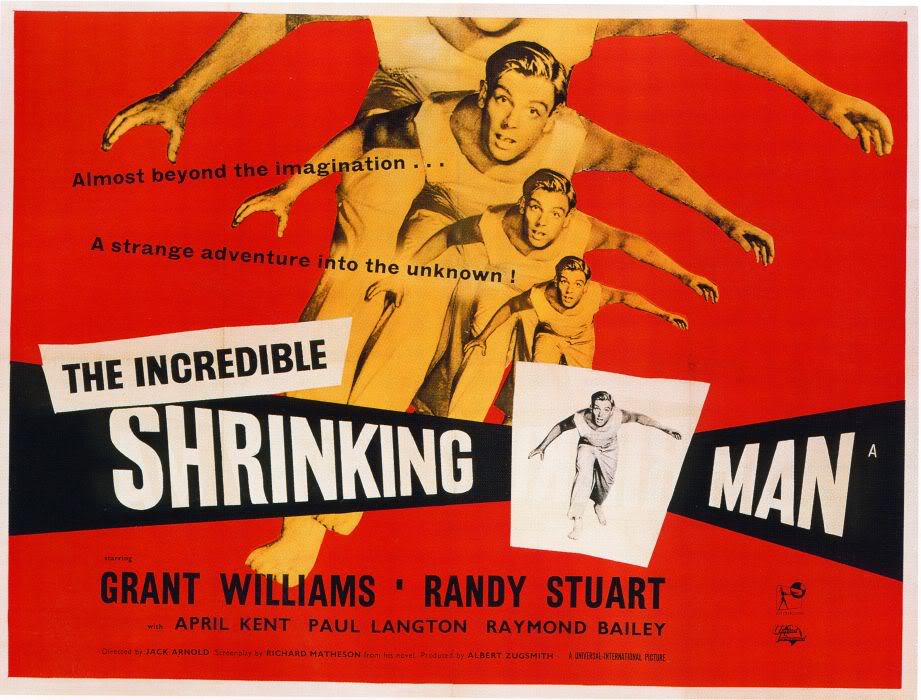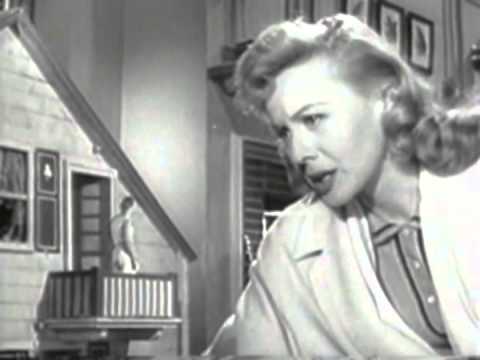IMDb meta-data hour and 21 minutes, rated 7.7 by 13,422 cinemitizens
Verdict: Deserves a higher rating. Much.
Grant Williams gradually finds his clothes are getting bigger. Hmmm. Is it the new laundry detergent? Is he losing weight? Is his ego diminishing? He consults Mr Pomfritt (in a very early role) and finds it is none of the above.

Act I is the shrinking Grant, which was caused by a freak combination of exposure to pesticides and then later to radiation in separate incidents, each an accident. Separately each exposure was harmless but in sequence… While medical science is mobilised, Grant denies this is happening to him. But then medical science fails.
Act II, Grant reacts in anger to his loss of stature. He lashes out at his wife, gamely played by Kansan Randy Stuart. He becomes ensconced in a doll house with ever smaller Ken Doll clothing. There is some bargaining here as for a time his shrinking seems arrested, but only for a time.
Grant becomes a media spectacle as the meat eaters nearly batter down his door to get pictures of this living Ken Doll freak with the sensitivity we have come to expect of the free media. The vultures can never get enough dead meat. That kindles a siege mentality in Grant.
Act III, the cat! The one-time pet cat has to be kept out of the house now, and, [see if you can guess] it sneaks in one day as Randy is leaving for work. Someone has to earn a crust since micro-Grant is no longer payroll material.
In the battle with the cat, Grant is shut into the cellar, and the final act is his struggle to survive in the vast, inhospitable reaches of this savage world of half empty paint cans, off cuts from carpets, cracked tiles, battered suit cases, a rusty lawn mower, a leaking water heater, a gaseous furnace, and the cellar wild life that is larger than he is. He is at first depressed but then wills himself to continue. There are some great moments here as this mini-Tarzan struggles against the odds in this terrifying yet mundane world.
But he continues to shrink and he comes to accept his fate as cosmic unity, or something. The end.
The master narrative is that as Grant changes physically, he also changes emotionally, mentally, and spiritually. The mental changes born of frustration and fear drive a wedge between his only solace, Randy, and himself. He knows he is doing it, but cannot stop himself.

The ending is downbeat. The wife thinks the cat got him. End of cat is implied. But there is no feline autopsy to be sure, as recommended by the fraternity brothers. She moves out of the house leaving the ever diminishing Grant to his fate in the basement wilderness. It is inhospitable enough to be Mars or New Jersey to mini-Grant.
There are fine setups and shots of the kind that made director Jack Arnold’s name. The performances are exact. The special effects work. There are two sidebars that illustrate the downward spiral that Grant is in. There are no villains to make it black and white.
It is a character study. This happens and the is how people react.
When the Hollywood remake comes, it can star Tom Midget. No special effects will be needed.
In a masochistic effort to watch all the many freely available John Agar movies so that I might have ontological dinner party bragging rights, I tried to watch ‘The Attack of the Puppet People’ (1958) but found the sludge so deep that I became mired, and instead read about it and to discover it was an imitation of ‘The Incredible Shrinking Man,’ which had much better reviews so I had a look and I am glad I did.
I find slipping the word ‘ontological’ gratuitously into a conversation usually stops the quibbles.
The fraternity brothers mainly slept through this one. ‘Too wordy,’ one of them drooled. ‘A house cat does not make a Creature Feature,’ muttered another.
Skip to content
